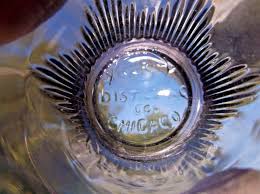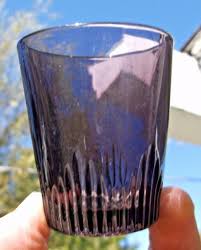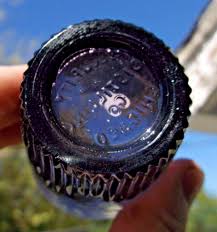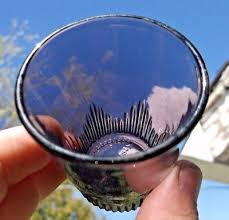This article is about one of the bad things that can happen to pre-pro glasses. By “bad”, I mean anything that tends to decrease value. There are several categories of bad. Damage to the inscription (fading/general wear, scuffs, flaking of the etching compound) is the most common. Cracks are generally a death sentence. Rim chips and dings are so prevalent that we tend to overlook them unless the damage is significant. Glasses that have been dug out of privvies are usually clouded (i.e., sick glass) and are essentially worthless. And then there is purple “desert” glass.
Back in September 2017, eBay seller lookwhatidug listed an embossed Security Distilling Co. glass with an opening bid of $55, as shown below. The auction title read “NICE RARE EMBOSSED SHOT GLASS SECURITY DISTILLING CO CHICAGO 1905 ERA CLEAN L@@K” Condition: “NO DAMAGE AT ALL AND IS SHINY CLEAN:”

The Security Distilling Co. of Chicago, IL. has the dubious distinction of being a nationwide leader in the mail-order hooch business yet distributing some of the least-inspiring shot glasses of all the many vendors in pre-pro days. I’m not even sure how many different glass variants they put out because I invariably get distracted by an urgent need to check the weather forecast or clean gunk out of my iPhone earbuds whenever I try to focus on possible differences between them. I think I may have one or two in my own collection, but…. oh, looks like rain tomorrow. ‘Nuff said.
What I can say is that the glass with the company name embossed in the base is relatively rare. It has such a generic look that it’s easy to miss the fact that it’s a distillery glass when hunting for pre-pro glasses in the wild – how often does one look at the base rather than the side? Not often, for sure.
Embossed glasses are much more resilient and less prone to breakage than their thin-walled, etched bretheren, so they tend to be less valuable; the one above is probably worth $15-$20, although I’ve seen them sell for more. $55 is a bit of a stretch, however, so it’s not surprising that it went unsold, even after a couple of relists and price reductions. Eventually the glass dropped off eBay.
lookwhatidug apparently is one of those bottle collectors that believes that even a crap, worthless bottle can be transformed into a work of art by turning it purple (or “amethyst” as it’s known in the biz).
How does one do this? In early pre-pro days, manganese dioxide (MnO2) was added to glass during manufacture to decolorize it. If added in large quantities, MnO2 colors glass purple, but small quantities bind impurities that would otherwise render glass muddy, thereby causing it to become crystal clear. If left out in the sun, however, MnO2-clarified glass takes on an amethyst hue due to the effect of UV light on the manganese, which is why older bottles displayed in windows slowly turn purple over time. MnO2 was replaced by other decolorizing agents that do not respond to UV light early in the 20th century, so amethyst is typically a mark of an older glass.
Judging by how many of lookwhatidug‘s auction listings feature “NICE PURPLE” in the title, the seller must have a barn filled with tanning beds devoted to the purpling process. So, thinking that what’s good for crap bottles is also good for crap embossed Security Distilling Co. shot glasses, into the tanning salon it went. After several months, it re-emerged on eBay with a nasty sunburn. This time the auction title read “NICE AMETHYST SHOT GLASS SECURITY DISTILLING CO CHICAGO 1905 ERA CLEAN L@@K” Condition: “NO DAMAGE AT ALL AND IS SHINY CLEAN:”
To my mind, purpling a glass amounts to vandalism. Why not get hold of a diamond-tipped pencil and engrave little hearts and flowers all over the wall of the glass to further enhance its appeal?! Or fill it with vanilla/cinnamon-scented wax and stick a wick in the center? Maybe give it a coat of sparkly paint? Oy.
To be fair, purpling an embossed glass does not automatically turn it into a write-off because the inscription is preserved, but it’s difficult to see that giving glasses the color of a nasty bruise in any way increases their attractiveness, especially on display. You should NEVER purple an etched glass under any circumstances because the inscription is swallowed by the color change (i.e., contrast between inscription and the background is lost) and you might as well toss the glass in the recycling bin for your efforts.
To end on a brighter note, the purpling process can be reversed by heating the glass. Sadly, the temperatures needed to achieve reversal approximate those found in the center of the sun, so a thin-walled glass will be reduced to a puddle, albeit a nice, crystal-clear puddle. I exaggerate, but the take-home is that it’s better not to purple pre-pro glasses in the first place. Pretty please.
The glass above circled the eBay drain for a few weeks and relists, eventually selling for $28.95 during a 10% off sale.







